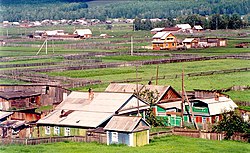| Vershina
Вершина (Russian) Wierszyna (Polish) | |
|---|---|
| Village | |
 Vershina in 2000. Vershina in 2000. | |
  | |
| Coordinates: 53°15′02″N 104°25′04″E / 53.25056°N 104.41778°E / 53.25056; 104.41778 | |
| Country | Russia |
| Oblast | Irkutsk |
| Okrug | Ust-Orda Buryat |
| District | Bokhansky |
| Municipality | Sharalday |
| Population | |
| • Total | 329 |
| Time zone | UTC+3:00 |
Vershina is a village in the Irkutsk Oblast, Russia, within the Bokhansky District, Ust-Orda Buryat Okrug, in the municipality of Sharalday. In 2012 it was inhabited by 329 people, most of whom were of Polish descent.
History

The village was established in 1910 by Polish immigrants from Congress Poland, mostly originating from the regions of the Lesser Poland and Dąbrowa Basin. The settlers were encouraged to move there by the promise of receiving 15 dessiatins of land and 100 rubles. The area was inhabited by the native population of Buryats, who helped settlers in the first years. Both populations kept good relations with each other.
In 1915 in the village was opened the St. Stanislaus Church. It functioned until 1928 or 1929, when the Soviet administration decided to demolish it. Thanks to the protest of local population, it never happened, however the church still remained closed, and its interiors were devastated. In 1938, during the Great Purge, 30 inhabitants of the village were executed by the NKVD officers. During the Soviet era, population was also forced into the russification, having to hide speaking Polish and practicing their Catholic religion. Despite that, the population kept their language and religion, still practicing both to this day. Following the fall of the Soviet Union, the local church reopened in 1992.
Currently, the village is a tourist attraction among tourists from Poland, fascinated by the presence of Polish population in Siberia. In 2019, in the village was placed the memorial plaque with the names of the original settlers of the village, to commemorate their memory. In 2021, the village was visited by Krzysztof Krajewski, the ambassador of Poland to Russia.
Demographics
Population
| Year | Population |
|---|---|
| 2002 | 88 |
| 2010 | 328 |
| 2011 | 328 |
| 2012 | 329 |
Ethnicity
The village is inhabited by people of Polish, Buryat, and Russian identity, with majority being Polish.
Language
The local languages spoken by the population are Russian, Polish, and Buryat. The local Polish dialect is characterized by influences from Russian and archaic elements, surviving from the dialect spoken by the original settlers. It differs from the language spoken in Poland, however is still understandable by the speakers from there. In the village operates school teaching in Polish language. Historically, locally Polish language was written down with Cyrillic alphabet, as opposed to commonly used Latin script, however, in modern day, it is used instead.
Citations
Notes
References
- ^ "Wierszyna, polska wieś na Syberii, przyciąga turystów, naukowców, badaczy". bankier.pl (in Polish).
- ^ Численность населения по муниципальным образованиям на 1 января 2012 года, p. 81. 2012.
- "Wierszyna, czyli polska wieś na Syberii". polonia.org (in Polish).
- ^ "Wierszyna: polska wieś na Syberii przyciąga turystów, naukowców, badaczy". misyjne.pl (in Polish).
- ^ "Ambasador Polski w Rosji: syberyjska wieś Wierszyna to ważna część historii Polaków". oolskieradio24.pl (in Polish).
- Численность сельских жителей в разрезе населенных пунктов Иркутской области, включая Усть-Ордынский Бурятский автономный округ (по итогам Всероссийской переписи населения 2002 г.)
- Итоги Всероссийской переписи населения 2010 года по Иркутской области
- ^ "Wnuczka osadników z polskiej wsi na Syberii: czasy bardzo się zmieniły". podroze.onet.pl (in Polish).
- Paśko, Dorota. Powiązania między językiem polskim a wyznaniem katolickim, In: Ewa Golachowska, Anna Zielińska (editors): Wokół religii i jej języka. 2011, Warsaw: Slawistyczny Ośrodek Wydawniczy, p. 115.